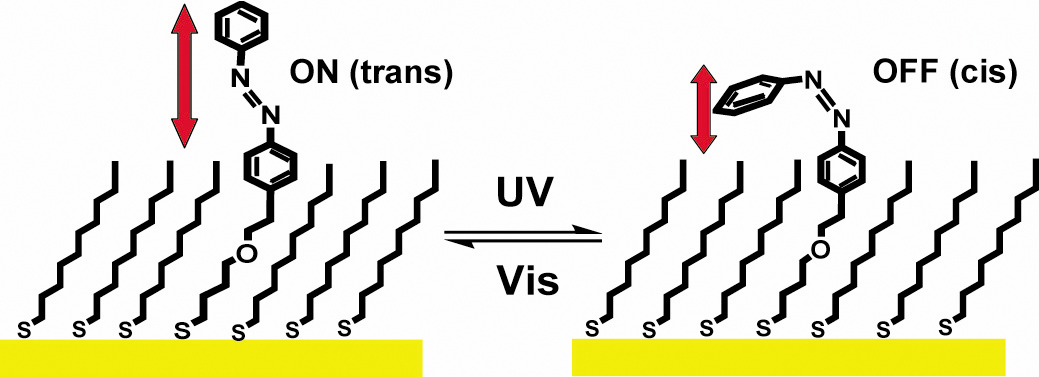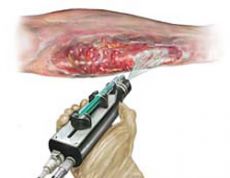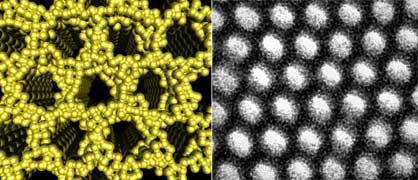
Researchers Develop Microscopic Mechanical Switches Powered by Light
Source: Dailytech
Light-powered microscopic mechanical switches could act as artificial muscle.
Research being done by collaboration between Penn State University and Rice University scientists may pave the way for switching state molecules. They could be used for anything from molecular driver units to artificial muscles or molecular electronics.
Though the function of the molecular switches is similar to that of memory metal, like the kind used to control the tiny mirrors that comprise the surface of a DLP (digital light processing) chip, they function without electrical stimulus. Rather than using an on-off state powered by charge, they react to ultraviolet and visible spectrum light.
These types of molecules, molecules that react and switch states of configurations to light, are not uncommon. The process is called photoisomerization. The molecules can either be in a trans or cis state. For their results, the trans state, which represented the “on” state of the switch, was the default state under normal visible light. The molecules, composed of two benzene rings joined by double bonded nitrogen atoms, “flipped” to a cis or “off” state when exposed to ultraviolet light instead.

Massive New Solar Parks Coming to Japan
Source: Dailytech
The first of the two new plants will be located in District No. 7-3, an industrial waste district. When completed, it will pump out 10 MW of power to the region. The second power plant is dubbed the “Sakai complex solar power generation facility”. A location has yet to be decided but it will produce 18 MW, bringing the plants combined production to 28 MW.
The plants will produce enough electricity to power much of the city and will help cut its CO2 emissions by 10,000 tons per year. Production on the first plant will start soon, and both plants are expected to be online by 2010.

Tests Indicate Martian Soil Could Support Life
Source: Dailytech
Scientists gleefully report that the Martian soil is able to support life
NASA scientists working the Phoenix Mars Lander mission believe the soil in Mars could support life, but will continue to gather evidence to be entirely sure.
Using the lander, scientists discovered the Martian soil is more alkaline than they initially expected before landing on the Red Planet. The discovery made them “flabbergasted,” with findings made after a wet chemistry experiment was made by Phoenix on Wednesday.Phoenix’s robotic arm collected a cubic centimeter of Martian soil just one inch below the surface. Once inside of Phoenix, it was mixed with Earth water and heated in an oven.
“We basically have found what appears to be the requirements, the nutrients, to support life whether past present or future,” said Sam Kounaves, project lead chemist who works at the University of Arizona.
The soil is “very friendly” and “it is the type of soil you would probably have in your back yard, you know, alkaline,” Kounaves said. “You might be able to grow asparagus in it really well … It is very exciting for us.”
The preliminary results show the alkaline soil has a pH level of between eight and nine. They reported magnesium, potassium, chloride and sodium were also found, with each mineral also found in soil here on Earth. The soil could grow asparagus beans or turnips, but is too acidic for strawberries or blueberries.
Scientists now wonder what they’ll be able to find even further nutrients once they begin to dig deeper below the surface.


Laser Surgery Probe Targets Individual Cancer Cells
Source: Dailytech
New laser probe will enable surgeons to zap away cancer and other dangerous cells, leaving the healthy completely unharmed.
Femtosecond lasers are a relatively recent advance in laser technology, but they are advancing quickly. The University of Missouri’s UUL, or ultra-fast, ultra-intense laser is a femtosecond pulse laser. Some of the medical purposes the creators envisioned were zapping cancer cells without harming healthy tissue and treating tooth decay with the same type of results.
Adela Ben-Yakar at the University of Texas at Austin has taken the track seriously. Her work on a new probe-based laser system has been published in the June 23 issue of Optics Express. To get away from large, bulky lasers that are difficult to use in delicate situations, Ben-Yakar developed a flexible probe to deliver the femtosecond pulses her laser produces.
The probe itself is presently about 15mm in diameter, but Ben-Yakar hopes to further reduce the size to 5mm, allowing the laser to be used like endoscopes in laproscopic surgeries.
The magic in the probe is the specially developed fiber optic cable that carries the infrared pulses from the laser unit to its target. The cable itself is responsible for condensing slightly longer and weaker pulses into more powerful bursts at the emission end. This helps protect the fiber cable from the power of the laser’s full potential while letting the full potential reach the target. The laser focuses light so keenly that it is able to pinpoint cancer cells, destroy them, and leave the surrounding cells completely unharmed.

Spray-on Skin, AFIRM's Research Leading Regenerative Medicine
Source: Dailytech
Advances in regenerative medicine and stem cell research will help wounded soldiers and civilians alike.
The goal of the Army-led organization is to help and heal our wounded fighting men and women, allowing them to return to the productive lives they gave to their country. Some of the current goals, limb regeneration especially, may seem lofty, but such things rarely stand in the way of human determination for long.
Some of the stem cell research done by AFIRM members is already showing promising results. Stephen Badylak, a pathologist at the McGowan Institute for Regenerative Medicine at the University of Pittsburgh’s announcement last year that a magical “pixie dust,” created from pig bladders, regrew the severed fingertips of two patients left a mark in the medical community. The dust contains molecules that signal growth factors, overriding the typical scar tissue response when a limb is severed. In just six weeks, the fingertips grew back completely, fingernails included. Badylak is presently doing further research into regrowing more complicated extremities such as arms and legs.

Scientists Devise Learning Brain Interface to Control Prosthetics
Most Powerful Visualization System Ever Is Faster than 600 Consoles
Source: Gizmodo
This is NASA’s hyperwall-2, the world’s highest resolution visualization system. At 23 by 10 feet wide, hyperwall-2 uses 128 screens driven by 128 graphic processing units with a total of 1,024 processor cores capable of displaying quarter billion-pixel graphics. That’s 74 teraflops of power—the number-crunching capacity of six hundred last-generation consoles— accessing 475 terabytes of data
32 GB SSD from OCZ for 149 euro
Source: fudzilla
We just heard that in the next few days OCZ plans to introduce a new line of very fast and affordable SSD drives in 32, 64 and 128 GB capacities.
The drives are based on SLC memory and they are all 2.5-inch models using the SATA II interface.
The read speed should be between 120 and 143MB/s, while the write speed should hit a quite amazing 80 to 93MB/s. The drive is shock resistant to 1500G.
The products will be known as OCZSSD2-1C32G, OCZSSD2-1C64G and OCZSSD2-1C128G and you can expect to be able to buy them as of next week.
The 32GB drive is already listed in German e-tail for €149, the 64GB has a really attractive price of €229, while the big 128GB drive will set you back €399.99.

Jail in Dubai for bringing basic medicines or food
Source: http://travel.timesonline.co.uk/tol/life_and_style/travel/news/article3333905.ece
Among the banned substances are foods containing poppy seeds; melatonin, which is taken to ease the effects of jetlag; codeine, a common ingredient in pain relief medication.
The charity’s chief executive Catherine Wolthuizen said: “We even have reports of the imprisonment of a Swiss man for ‘possession’ of three poppy seeds on his clothing after he ate a bread roll at Heathrow.”
That’s how fucked up that place is.
New Skyscraper Will Shift Shape Dynamically
Source: Dailytech


Mars Has Odd Shape Due to Meteor Strike
Source: Dailytech
Astronomers have been extremely curious as to why the Red Planet has such a unique geophysical shape in one hemisphere but not the other. The Martian crust is thicker in the southern hemisphere than the northern hemisphere, though astronomers never had anything but theories as to why this happened. Furthermore, there are significant magnetic anomalies in the south but north, which likely was caused after the space rock impacted the planet.
Once the rock hit the surface, researchers believe it had the energy equivalent of one million billion atomic bombs.
Dubbed the Borealis Basin, edges of the depression have been covered by lava that erupted from volcanoes and eventually erased part of the boundary lines.
More space programs have taken interest in the Red Planet, with several space agencies wanting to launch manned missions to Mars in the future. The NASA Phoenix lander continues to analyze the Martian surface looking for any signs of ice. After digging two small trenches into the surface last week, Phoenix likely found ice crumbs, which could be another sign that the Red Planet has the ability to support life.

Self-assembling Nanometals May Improve Fuel Cells, Microchips
Source: Dailytech
Cornell University researchers have found a way to assemble metals, platinum in this case, into a useful structure. Their work utilizes a co-polymer, a ligand and the metal particles themselves. Scientists have been chasing self-assembling metals via co-polymers for years, but it’s the addition of the ligand, which is used to facilitate a high density solution of metal particles, that makes this process work.
Once the solution is made, it is mixed with the co-polymer. Co-polymers form known and reliable structures and the scientists utilized this to create their final metallic structures. The platinum molecules combine with a single polymer in the mixture, which allows them to take on a shape controlled by the other polymer’s structure. For their tests, the Cornell researchers created a hexagonal honeycomb type structure out of the platinum nanoparticles.
Once the material has taken shape, it is annealed in an airless environment, which also turns the polymers into a carbon scaffolding. High temperatures are then used to burn away the carbon and oxidize the ligand. The metal particles melt on the exterior, allowing them to fuse together into a solid structure as the carbon scaffolding and ligand chemicals disappear.

Toyota, Medical Schools Back Revolutionary New Microspheres
Source: Dailytech

The Savannah Research National Laboratory have created a multipurpose new material, composed of tiny glass bubbles, which behaves both like a fluid and a solid
South Korea to Build Robot Cities by 2013
Source: weirdasianews

The South Korean government plans to build two robot-themed parks close to Seoul—one in the bustling seaport of Incheon and another in Masan—by the year 2013.


Recent Comments